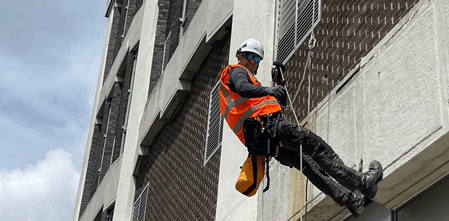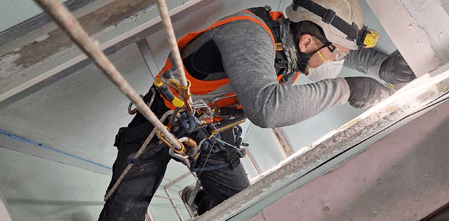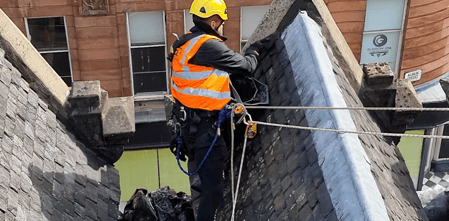Email. [email protected]
Rope access has redefined how we work at height, eliminating the need for bulky scaffolding or expensive access equipment. Whether you’re inspecting a skyscraper, repairing a wind turbine, or restoring a historic façade, rope access offers a fast, safe, and cost-efficient solution. At Abseiling Services, we’ve worked with hundreds of rope access technicians across Edinburgh and Glasgow, undertaking various rope access jobs, and we know what it takes to thrive in this exciting field.
This guide explores everything you need to know about rope access jobs, from job types and required skills to the many benefits and career opportunities ahead.

Rope access jobs refer to roles that involve using industrial rope systems to safely reach and carry out work at height or in hard-to-reach places. These jobs are not only physically demanding but also require technical expertise, careful planning, and strict safety adherence. Whether it’s window cleaning on a glass tower, welding under a bridge, or painting a wind turbine, rope access technicians are the professionals who make it possible, safely and efficiently.
Unlike traditional access methods like scaffolding or lifts, rope access is quicker to set up and dismantle, reducing downtime and overall costs. This approach is widely used in both urban environments and remote, industrial settings. In cities like Glasgow and Edinburgh, rope access technicians are in high demand due to the growing need for building maintenance, inspections, and specialist restoration.
Rope access jobs span a wide array of sectors and specialisations, making it a highly versatile career. Whether in construction, energy, or building maintenance, rope access technicians are essential for performing tasks in areas that are otherwise difficult to reach using traditional access methods.
Tasks such as façade repairs, window cleaning, waterproofing, repointing, and gutter clearance are common in urban environments, especially in cities like Edinburgh and Glasgow, where high-rise and historic buildings are prevalent. These jobs require precision, safety awareness, and the ability to work comfortably at height.
One of the most critical roles in rope access services, inspections involve assessing the integrity of structures such as bridges, wind turbines, towers, and offshore rigs. Rope access Technicians may carry out visual inspections or use tools for non-destructive testing (NDT), corrosion mapping, and photography. Rope access inspection is preferred in many industries due to its minimal disruption and lower cost compared to scaffolding.
High-altitude painting, fireproofing, and coating applications are common in industrial rope access work. These tasks are particularly important for protecting infrastructure in corrosive environments, like offshore platforms or maritime facilities.
From installing signage to high-level glazing or fixing architectural features, rope access can replace expensive cranes and bulky scaffolding. It’s widely used in both modern and heritage structures, offering unmatched flexibility in project execution.
In remote or rugged terrains, rope access teams may conduct rockfall protection, slope stabilisation, netting installation, and geotechnical surveys. These are highly specialised roles, often demanding cross-disciplinary experience.
The oil and gas sector relies heavily on IRATA rope access technicians for inspection, maintenance, welding, and painting. Jobs in offshore environments are physically demanding but offer high pay and international opportunities.

Succeeding in rope access jobs requires more than just a head for heights. It demands a blend of technical skills, physical fitness, and certified training, especially if you’re pursuing a professional path with companies like Abseiling Services.
IRATA (Industrial Rope Access Trade Association) certification is the global standard in rope access training. There are three levels:
This tiered system ensures progression and competence.
Rope Access Technicians must have strong core stability, good balance, and stamina to work in suspended environments for long periods. This is particularly important for roles that involve rope access in Glasgow’s wind-swept sites or the unpredictable weather of Edinburgh.
Depending on the job, technicians might need additional skills such as:
These specialised abilities are in high demand and enhance employability.
Understanding fall protection systems, risk assessments, and emergency protocols is vital. Communication skills are equally important, especially for coordination during high-risk operations or when working as part of a rescue team.
Rope access work offers a range of benefits that make it an appealing choice for many tradespeople, climbers, and adventure-seekers transitioning into professional careers.
High Earning Potential: Qualified rope access technicians, particularly at IRATA Level 2 or 3, often earn significantly more than traditional tradespeople. Offshore and international roles can be especially lucrative.
Travel Opportunities: Jobs frequently take technicians across the UK and abroad, from remote wind farms in Scotland to oil rigs in the North Sea or skyscrapers in the Middle East. For those who love adventure and variety, this career offers unparalleled opportunities.
Job Diversity: Because rope access services are used in so many industries, including construction, civil engineering, energy, and renewables, no two projects are ever the same. You might be painting a historic building in Edinburgh one week and inspecting a suspension bridge the next.
Low Environmental Impact: Compared to scaffolding or aerial platforms, rope access has a minimal footprint. It doesn’t require road closures, heavy equipment, or invasive setups, making it a more sustainable and less disruptive choice.
Strong Career Progression: The structured IRATA system encourages continuous learning. Moving up the ranks leads to higher salaries and leadership roles, such as Rope Access Supervisor or Safety Manager.
Tight-Knit Community and Safety Culture: The rope access world is built around trust and communication. Rope access Technicians often work in pairs or small teams where safety, accountability, and camaraderie matter. The culture is professional, respectful, and supportive, a rare find in many high-risk professions.

Rope access presents a dynamic and rewarding career path for those seeking challenges and opportunities at height. With the right training, certifications, and experience, you can become a proficient rope access technician, contributing to vital projects across various sectors.
At Abseiling Services, we pride ourselves on delivering exceptional rope access services in Glasgow, Edinburgh, and beyond. Our team of certified professionals is committed to safety, efficiency, and excellence in every project. Get in touch with us today for your rope access needs.
WE OFFER FREE ESTIMATES AND ALWAYS QUOTE THE BEST POSSIBLE PRICE